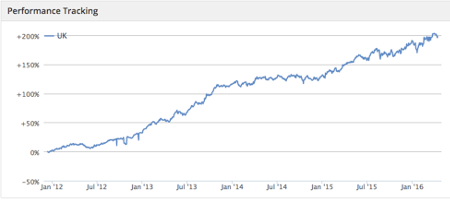10 fast growing dividend paying companies
13th April 2016 14:12
by Stockopedia from interactive investor
Share on
Fifty years ago this summer, England's footballers were basking in World Cup glory. It was an achievement that the country's subsequent teams have so far failed to reproduce. But 1966 wasn't just a footballing high. That year, industry figures show that the average holding period of a stockmarket-listed share was almost eight years. Half a century on, the average holding period is barely eight months.
A steady fall in the length of time that shares are held by investors points to a change in mindset that's shifted them away from thinking long-term to chasing growth wherever they can find it. Given the headline-grabbing attention of some of the market's greatest growth stocks, this change in focus is hardly surprising. But it misses some important points about the powerful compounding effects of long-term capital and dividend growth.
It's an argument summed up neatly by respected equity analyst James Montier, who wrote that: "…to those with an attention span measured in longer than milliseconds - who are few and far between, to judge from today's markets - dividends are a vital element of return."
The power of compounding
To get an understanding of how long-term investing can enhance performance, you need only look to the research coming out of London Business School. Professors Elroy Dimson and Paul Marsh and Dr Mike Staunton regularly document long-term market returns. Last year they again showed that, while year-to-year stock market performance is driven by capital appreciation, long-run returns are dominated by reinvested dividends.
They found that in the UK, in the 115 years since 1900, an index fund with dividends reinvested would have grown to more than 170 times the value it would have attained without dividend reinvestment.
Given the compelling argument in favour of dividend reinvestment, it's perhaps no surprise that even hardened growth stock investors like the late Jim Slater take dividend payments seriously. In his book, The Zulu Principle, Slater wrote: "I prefer companies to pay a dividend, as most institutions need an income stream from their investments.
"Also, the dividend payment and forecast (if any) to some extent corroborate the management's confidence in the future. The ideal company will have a steadily increasing dividend growing broadly in line with earnings."
So what happens when you start combining growth investing rules with the traditional dividend measures that are favoured by income investors, such as yield? Remarkably, the answer is one of the best-performing screens tracked by Stockopedia.
In just over four years, a strategy that looks for companies that are being upgraded by analysts, that have above average profitability and below average valuations plus strong yields has returned nearly 200% excluding dividends.

Now, that figure doesn't take into account the drag of trading costs or the bonus of dividend payments. But, overall, the strategy has proved to be pretty good at finding strong returns - although additional research is always needed. Here's a snapshot of how the screen currently stacks up.
| Name | Mkt Cap (£m) | % 3m EPS Upgrade FY2 | Return on equity % | PE Rolling 1y | Yield % |
|---|---|---|---|---|---|
| Berkeley | 4,163 | 2 | 24.6 | 7.7 | 6.3 |
| Numis | 228.8 | 19 | 19.1 | 8 | 5.7 |
| Galliford Try | 1,079 | 3 | 18.3 | 8.8 | 5.5 |
| Kier | 1,195 | 0.9 | 5.12 | 10.6 | 4.6 |
| J Sainsbury | 5,501 | 1.6 | 7.2 | 13.2 | 4.3 |
| Direct Line Insurance | 4,979 | 0.6 | 14.7 | 12.6 | 3.8 |
| Meggitt | 2,982 | 4.1 | 8.43 | 11.4 | 3.7 |
| Interquest | 32.5 | 5.5 | 13.2 | 7.3 | 3.4 |
| Novae | 543.2 | 4.9 | 15 | 11.2 | 3.2 |
| Acal | 160.8 | 0.7 | 7.61 | 13.2 | 3.1 |
It's a list that has a good spread of small, mid and large-cap stocks, with micro-cap recruitment company rubbing shoulders with supermarket giant .
Sorted for yield, it's housebuilders like and that lead the way with yields of 6.3% and 5.5% respectively, punctuated by broking firm on 5.7%.
Elsewhere, there is construction services group , engineering firm and insurance firms like and .
Mixing growth and income
For investors tempted by the excitement of growth but conscious of the long-term compounding benefits of reinvested dividends, a combined growth and income strategy could be a useful place to start.
As always, care is needed, particularly because when it comes to dividends. Very high yields can be a signal that the market no longer believes that the payout is sustainable.
But looking for signs of strengthening profitability, an improving outlook and below-average valuations could help in the search for growth companies with an added dividend kick.
This article is for information and discussion purposes only and does not form a recommendation to invest or otherwise. The value of an investment may fall. The investments referred to in this article may not be suitable for all investors, and if in doubt, an investor should seek advice from a qualified investment adviser.
About Stockopedia
Interactive Investor's Stock Screening series is written by Ben Hobson ofStockopedia.com, the rules-based stockmarket investing website. You canclick here to read Richard Beddard's review of Stockopedia.com and learn more about the site.
● Interactive Investor readers can enjoy a completely FREE 5-day trial of Stockopedia by clicking here.
It's worth remembering that these and other investment articles on Interactive Investor are simply for generating ideas and if you are thinking of investing they should only ever be a starting point for your own in-depth research before making a decision.
*No fee for publication is involved between Interactive Investor and Stockopedia for this column.

Ben Hobson is Investment Strategies Editor at Stockopedia.com. His background is in business analysis and journalism. Ben researches and writes regularly on investment strategy performance and screening ideas for Stockopedia.com. He is the author of several ebooks including "How to Make Money in Value Stocks" and "The Smart Money Playbook"